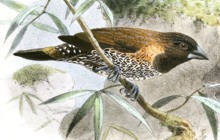| Black-throated munia | |
|---|---|

| |
| Lonchura kelaarti jerdoni | |
| Scientific classification | |
| Domain: | Eukaryota |
| Kingdom: | Animalia |
| Phylum: | Chordata |
| Class: | Aves |
| Order: | Passeriformes |
| Family: | Estrildidae |
| Genus: | Lonchura |
| Species: | L. kelaarti
|
| Binomial name | |
| Lonchura kelaarti (Jerdon, 1863)
| |
The black-throated munia or Jerdon's mannikin (Lonchura kelaarti) is a small passerine bird. This estrildid finch is a resident breeding bird in the hills of southwest India, the Western Ghats, Eastern Ghats and Sri Lanka.
YouTube Encyclopedic
-
1/1Views:8 389
-
Birdwatching - Finch kissing
Transcription
Habitat
The black-throated munia is a small gregarious bird which feeds mainly on seeds. It frequents open hill woodland and cultivation. The nest is a large domed grass structure in a tree or creepers on a house into which 3-8 white eggs are laid in India, and usually five in Sri Lanka.[2]
Characteristics

The black-throated munia is 12 cm in length with a long black tail. The adult of the southwest Indian population, L. k. jerdoni, has a stubby grey bill, dark brown upperparts with pale shaft streaks; a blackish face and bib; and pinkish brown underparts with scaly marking towards the vent. The Eastern Ghats form vernayi has paler pinkish underparts. The nominate form L. k. kelaarti of Sri Lanka has scaly patterning on the underparts and vent with the pale almost whitish shaft streaks contrasting on the darker back. The sexes are similar in all populations, but immatures lack the darker face and have more uniform underparts.[2]
Commemoration
The binomial commemorates the zoologist Edward Frederick Kelaart and the name was given by Thomas C. Jerdon in 1863.
References
- ^ BirdLife International (2018). "Lonchura kelaarti". IUCN Red List of Threatened Species. 2018: e.T22719818A132131997. doi:10.2305/IUCN.UK.2018-2.RLTS.T22719818A132131997.en.
- ^ a b Rasmussen, Pamela C.; Anderton, John C. (2005). Birds of South Asia. The Ripley Guide. Volume 2. Washington DC & Barcelona: Smithsonian Institution and Lynx Edicions. p. 573.

